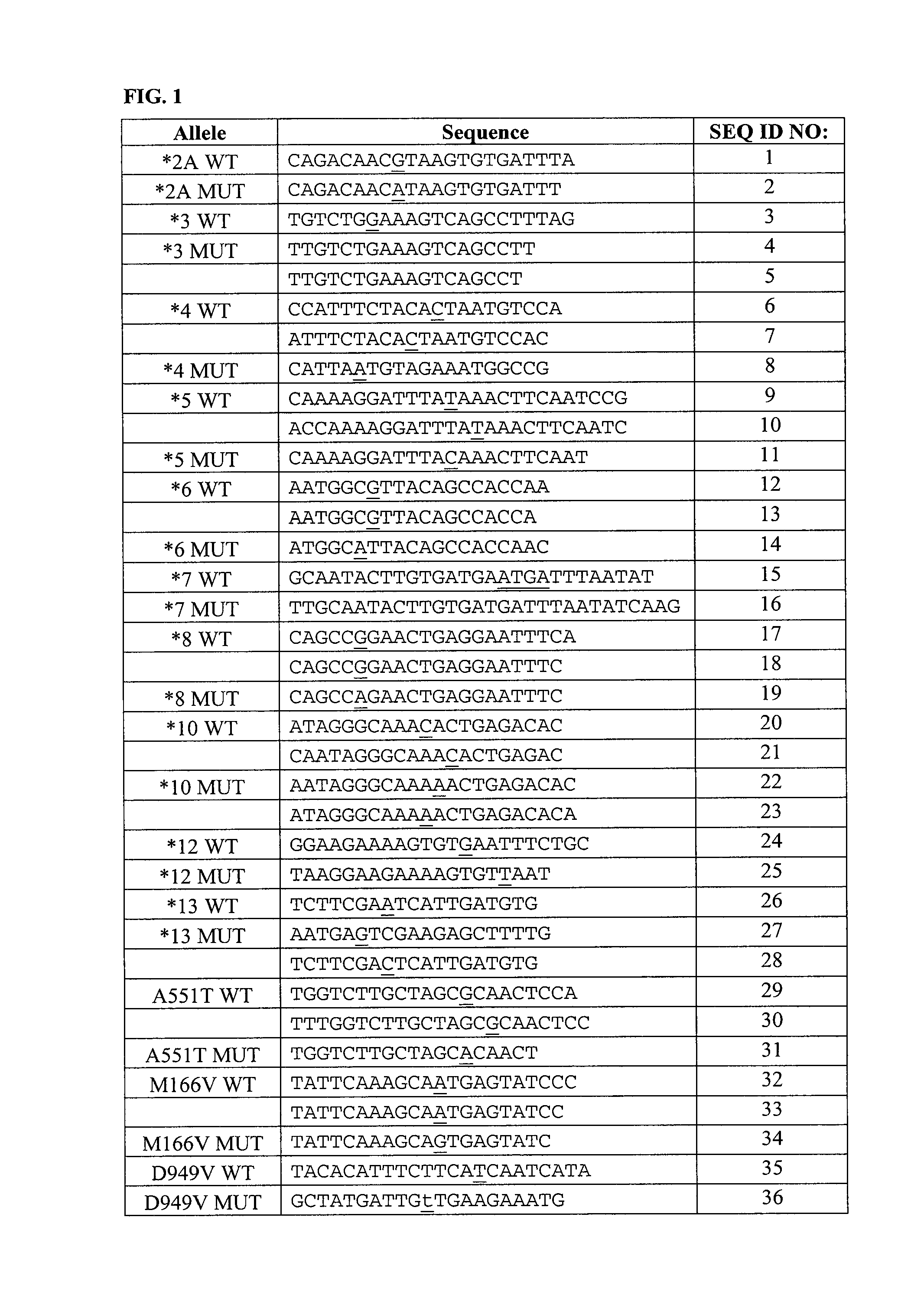Genotyping Dihydropyrimidine Dehydrogenase Deficiency
a technology of dihydropyrimidine and dehydrogenase, applied in the field of drugcogenetics and molecular detection, can solve the problems of inability of affected patients to degrade 5-fluorouracil fast enough or even at all, and achieve the most accurate and comprehensive predictive risk profile for a patien
- Summary
- Abstract
- Description
- Claims
- Application Information
AI Technical Summary
Benefits of technology
Problems solved by technology
Method used
Image
Examples
example 1
[0214]The protocols described herein were performed to prepare numerous samples for testing on various solid supports comprising different combinations of capture probes. Three different solid support arrays having three different sets of capture probes were used. A variety of probes and primers have been tested and are shown in the Figures. A number of probes were rejected because they were too short or too long, causing insufficient or unspecific binding of target.
[0215]For the first chip, hybridisation temperatures were varied between 54 and 60° C. For amplification, primers amplifying just single targets in no multiplex reactions were exclusively used. The following primers were tested:
*2A 14Forward:5′-CATGTATGGCCCTGGAC-3′Reverse:5′-AACTTATGCCAATTCTCTTGTTT-3156*10 23Forward:5′-CAGTGACATCAATACCCTCTA-3′Reverse:5′-TTTGGTTCATAAGGTGTTGTCC-3′168*9B 2 / 21Forward:5′-TGAGCTAACATGCTTCCTTATT-3′Reverse:5′-AAACAGTTTCTCTTAAGTGGTGA-3′153*9A 2Forward:5′-AGAGAGACCGTGTCTCAA-3′Reverse:5′-TGGTACTTAC...
example 2
[0217]For the second chip, multiplex primers were used to amplify target. Here, variations in experimental conditions were tested. For example, hybridisation temperature was varied from 45-50° C. The following washing steps were tested following hybridisation (always 5 min with the respective washing buffers I-III from the above protocol at the given temperature):[0218]variant 1: 50 / 50 / 50 / 50[0219]variant 2: 50 / 50 / 50[0220]variant 3: 50 / 50 / 48[0221]variant 4: 50 / 50 / 45[0222]variant 5: 50 / 50 / 42[0223]variant 6: 50 / 50 / 40
[0224]Accordingly, an example image of the solid support showing the detection of a target can be seen in FIGS. 6B and 6C.
example 3
[0225]A third chip with a different combination of probes was also tested. Example images are shown in FIGS. 6D-6F.
[0226]A large amount of data has been collected for the three different chips. A small sample of this data is presented in FIG. 7, which shows signal detected from the three different chips.
[0227]The articles “a,”“an” and “the” as used herein do not exclude a plural number of the referent, unless context clearly dictates otherwise. The conjunction “or” is not mutually exclusive, unless context clearly dictates otherwise. The term “include” is used to refer to non-exhaustive examples.
[0228]All references, publications, patent applications, issued patents, accession records and databases cited herein, including in any appendices, are incorporated by reference in their entirety for all purposes.
PUM
| Property | Measurement | Unit |
|---|---|---|
| temperature | aaaaa | aaaaa |
| temperature | aaaaa | aaaaa |
| concentration | aaaaa | aaaaa |
Abstract
Description
Claims
Application Information
 Login to View More
Login to View More - R&D
- Intellectual Property
- Life Sciences
- Materials
- Tech Scout
- Unparalleled Data Quality
- Higher Quality Content
- 60% Fewer Hallucinations
Browse by: Latest US Patents, China's latest patents, Technical Efficacy Thesaurus, Application Domain, Technology Topic, Popular Technical Reports.
© 2025 PatSnap. All rights reserved.Legal|Privacy policy|Modern Slavery Act Transparency Statement|Sitemap|About US| Contact US: help@patsnap.com



